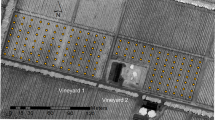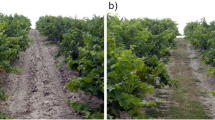Abstract
To obtain the best must quality, winegrowers must harvest uniform batches of grapes, thus they might define sub-units of the vineyard and treat them as separate management units for cultivation and harvest. The objectives of this work were to determine if there were variations of soil properties that could be arranged into different units of relative uniformity and separated from each other by discrete boundaries, and if there was a significant relationship between those units and the vegetative development and yield components of the grapevines. A soil index that is a linear combination of four soil characteristics was constructed and an interpolation method allowed the definition of soil areas with relative uniformity. These areas were significantly correlated with the vine growth that, in turn, had a significant correlation with the yield components of the vines. This methodology might prove useful to define areas within vineyards where the vegetative development and yields warrant a differentiated management within the vineyard.






Similar content being viewed by others
References
Adamchuk, V. I., Lund, E. D., Reed, T. M., & Ferguson, R. B. (2007). Evaluation of an on-the-go technology for soil pH mapping. Precision Agriculture, 8, 139–149.
Adekayode, F. O., Aderibigbe, A. O., Balogun, A. M., Adedayo, J. O., & Oladimeji, J. A. (2009). Use of geospatial technology in a precision soil fertility investigation of a farmland for arable crop production in a tropical environment. Journal of Food Agriculture Environment, 7, 852–855.
Andreas-de Prado, R., Yuste-Rojas, M., Sort, X., Andreas-Lacueva, C., Torres, M., Rosa, M., et al. (2007). Effect of soil type on wines produced from Vitis vinifera L. cv. Grenache in commercial vineyards. Journal of Agriculture Food Chemistry, 55, 779–786.
Ayoubi, S., Khormali, F., & Sahrawat, K. L. (2009). Relationships of barley biomass and grain yields to soil properties within a field in the arid region, use of factor analysis. Acta Agriculture Scandinava—A Soil Plant Science, 59, 107–117.
Bates, T. (2008). Pruning level affects growth and yield of New York concord on two training systems. American Journal of Enology and Viticulture, 59, 276–286.
Bodin, F., & Morlat, R. (2006a). Characterization of viticultural terroirs using a simple field model based on soil depth. I Validation of the water supply regime phenology and vine vigour in the Anjou vineyard (France). Plant and Soil, 281, 37–54.
Bodin, F., & Morlat, R. (2006b). Characterization of viticultural terroirs using a simple field model based on soil depth. II Validation of the grape yield and berry quality in the Anjou vineyard (France). Plant and Soil, 281, 55–69.
Boissonnat, J., & Cazals, F. (2001). Natural neighbor coordinates of points on a surface. Computational Geometry, 19, 155–173.
Corstanje, R., Grunwald, S., Reddy, K. R., Osborne, T. Z., & Newman, S. (2006). Assessment of the spatial distribution of soil properties in a Northern Everglades marsh. Journal of Environmental Quality, 35, 938–949.
Cortell, J. M., Halbleib, M., Gallagher, A. V., Righetti, T. L., & Kennedy, J. A. (2005). Influence of vine vigor on grape (Vitis vinifera L. cv Pinot Noir) and wine proanthocyanidins. Journal of Agriculture Food Chemistry, 53, 5798–5808.
Girona, J., Mata, M., del Campo, J., Arbonés, A., Bartra, E., & Marsal, J. (2006). The use of midday leaf water potential for scheduling deficit irrigation in vineyards. Irrigation Science, 24, 115–127.
Hall, A., Lamb, D. W., Holzapfel, B., & Journal, L. (2002). Optical remote sensing applications in viticulture—a review. Australian Journal of Grape and Wine Research, 8, 36–47.
Hillel, H. (1998). Environmental soil physics. New York, NY: Academic Press.
Johnson, L. F., Pierce, L., DeMartino, J., Youkhana, S., Nemani, R., & Bosch, D. (2003). Image-based decision tools for vineyard management. Paper no 033129, ASAE. St. Joseph, MI: ASAE.
Klute, A. (1986). Methods of soil analysis. Part 1. Physical and mineralogical methods. Madison, WI: Soil Science Society of America.
Ledoux, H., & Gold, C. (2005). An efficient natural neighbour interpolation algorithm for geoscientific modelling. In F. Fisher (Ed.), Developments in spatial data handling: 11th international symposium on spatial data handling (pp. 97–108). Berlin: Springer.
Martinez de Toda, F., Tardaguila, J., & Sancha, J. C. (2007). Estimation of grape quality in vineyards using a new viticultural index. Vitis, 4, 168–173.
McKinion, J. M., Willers, J. L., & Jenkins, J. N. (2010). Spatial analyses to evaluate multi-crop yield stability for a field. Computers and Electronics in Agriculture, 70, 187–198.
Miller, D. P., & Howell, G. S. (1998). Influence of vine capacity and crop load on canopy development morphology and dry matter partitioning in concord grapevines. American Journal of Enology and Viticulture, 49, 183–190.
Musingo, M., James, N., & Wang, L. (2005). Influence of grape maturity on pH color and total phenolics of red muscadine wine from grapes grown at Florida A&M University vineyard. European Journal of Science Research, 11, 206–217.
Ortega, R., & Santibáñez, O. A. (2007). Determination of management zones in corn (Zea mays L.) based on soil fertility. Computer and Electronics in Agriculture, 58, 49–59.
Pilar, B., Sánchez-de-Miguel, P., Centeno, A., Junquera, P., Linares, R., & Lissarrague, J. R. (2007). Water relations between leaf water potential photosynthesis and agronomic vine response as a tool for establishing thresholds in irrigation scheduling. Science Horticulture, 114, 151–158.
Ping, J. L., Green, C. J., Zartman, R. E., Bronson, K. F., & Morris, T. F. (2008). Spatial variability of soil properties cotton yield and quality in a production field. Communications in Soil Science and Plant Analysis, 39, 1–16.
Pozdnyakova, L., Giménez, D., & Oudemans, P. V. (2005). Spatial analysis of cranberry yield at three scales. Agronomy Journal, 97, 49–57.
Proffit, T., Bramley, R., Lamb, D., & Winter, E. (2006). Precision viticulture. A new era in vineyard management and wine production. Ashford, SA: Winetitles.
Reynolds, A. G., & Wardle, D. A. (2001). Evaluation of minimal pruning upon vine performance and berry composition of chancellor. American Journal of Enology and Viticulture, 52, 45–48.
Reynolds, A. G., Senchuk, I. V., van der Reest, C., & de Savigny, C. (2007). Use of GPS and GIS for elucidation of the basis for terroir, spatial variation in an Ontario Riesling vineyard. American Journal of Enology and Viticulture, 58, 145–162.
Schultz, H. R. (1995). Grape canopy structure, light, microclimate and photosynthesis. I A two-dimensional model of the spatial distribution of surface area densities and leaf ages in two canopy systems. Vitis, 34, 211–215.
Secretaria General Técnica. (2009). Encuesta sobre superficies y rendimientos de cultivos (survey on crop land and crop yields). Resultados de 2008. Retrieved July 9, 2009 from http://www.mapa.es/es/estadistica/pags/encuestacultivos/resultados.htm#art2.
Sibson, R. (1981). A brief description of natural neighbour interpolation. In V. Barnett (Ed.), Interpreting multivariate data (pp. 21–36). New York, NY: Wiley.
Simbahan, G. C., & Dobermann, A. (2006). An algorithm for spatially constrained classification of categorical and continuous soil properties. Geoderma, 136, 504–523.
Smart, R., & Robinson, M. (1991). Sunlight into the vine. A handbook for winegrape canopy management. Ashford, SA: Winetitles.
Soil Survey Staff. (2006). Keys to soil taxonomy (10th ed.). Washington, DC: USDA—National Resources Conservation Service.
Sparks, D. L. (1996). Methods of soil analysis. Part 3. Chemical methods. Madison, WI: Soil Science Society of America.
Tardaguila, M. J. (1996). Ruolo fisiologico dell’acua e del portinnestonella vite. Effetti sulla crescita e produttività (Physiological role of water and vitis rootstock. Effect on growth and productivity). PhD Dissertation, Universidad de Castilla-La Mancha.
Taylor, J., & Bramley, R. (2004). Precision viticulture, managing vineyard variability. In R. Blair, P. Williams, & S. Pretorius (Eds.), Proceeding of 12th Australian wine industry technical conference workshop (pp. 51–55). Melbourne Convention Centre, Australia.
van Leeuwen, C., Friant, P., Choné, X., Tregoat, O., Koundouras, S., & Dubourdieu, D. (2004). Influence of climate soil and cultivar on terroir. American Journal of Enology and Viticulture, 55, 207–217.
Vrindts, E., Mouazen, A. M., Reyniers, M., Maertens, K., Maleki, M. R., Ramon, H., et al. (2005). Management zones based on correlation between soil compaction yield and crop data. Biosystems Engineering, 92, 419–428.
Warrick, A. W., Myers, D. E., & Nielsen, D. R. (1986). Geostatistical methods applied to soil science. In A. Klute, et al. (Eds.), Methods of soil analysis. Part 1. Agronomy monographs 9 (pp. 53–82). Madison, WI: American Society of Agronomy.
White, R. E. (2006). Principles and practice of soil science: The soil as a natural resource. London: Wiley-Blackwell.
Wu, C., Wu, J., Luo, Y., Zhang, L., & DeGloria, S. D. (2008). Spatial prediction of soil organic matter content using cokriging with remotely sensed data. Soil Science Society of America Journal, 73, 1202–1208.
Acknowledgments
Domecq Bodegas. Richard Bennett, consultant.
Author information
Authors and Affiliations
Corresponding author
Rights and permissions
About this article
Cite this article
Tardaguila, J., Baluja, J., Arpon, L. et al. Variations of soil properties affect the vegetative growth and yield components of “Tempranillo” grapevines. Precision Agric 12, 762–773 (2011). https://doi.org/10.1007/s11119-011-9219-4
Published:
Issue Date:
DOI: https://doi.org/10.1007/s11119-011-9219-4




